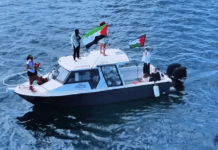A mini-documentary about 20 years of publication of the research journal Pacific Journalism Review, produced by AUT University screen production and television student Sasya Wreksono to mark the publishing milestone. Video: PMC on YouTube
Student protests at the University of Papua New Guinea that led to police opening fire on a peaceful crowd last year, Australian journalism training in the Solomon Islands, “cyberbullying” in Fiji, independent campus media, and Radio New Zealand International’s reporting of the Pacific are among topics featured in the latest edition of Pacific Journalism Review.

The journal was published online today on the new Tuwhera research platform at Auckland University of Technology with a special edition on journalism education in the Pacific.
Peer-reviewed papers have been drawn from the Journalism Education and Research Association of Australia (JERAA) and the Pacific Media Centre Preconference and the World Journalism Education Congress (WJEC16) conference at AUT last July.
Thirteen Asia-Pacific educators and journalists were funded to attend the conferences by the recently created NZ Institute for Pacific Research, Asia New Zealand Foundation, Transparency International New Zealand and UNESCO.
The University of Auckland’s Associate Professor Toeolesulusulu Damon Salesa, who opened the JERAA-PMC preconference, says in the editorial journalism is central to the public interest in the Pacific.
Dr Salesa, director of the new institute, says journalism protects culture and especially language. However, a fast-changing world is “making it difficult for journalists to keep up with the scale of some of the issues affecting the Pacific” – such as climate change.
The editorial also features his comments about the challenges to journalism educators.
Edition acting editor Dr Philip Cass writes about Wansolwara, the longest-running journalism school newspaper in the Asia-Pacific region – last year it celebrated 20 years of publishing in Fiji.
Dr Shailendra Singh and Eliki Drugunalevu assess three case studies of cyberbullying against truth-seeking student journalists in Fiji.
Managing editor Professor David Robie, on sabbatical last year, offers an analysis of the transformation of Pacific Scoop into Asia Pacific Report, the campus-based digital publication with the widest reach in the region.
Dr Alexandra Wake reports on her research into Australian post-conflict journalism training initiatives in Solomon Islands while Emily Matasororo reflects on the national university upheaval in Papua New Guinea last year climaxing in police shootings that left at least 23 people wounded.
Dr Matt Mollgaard examines the role of Radio New Zealand International as a source of information and a tool for “soft power” in the region.
Tongan publisher, broadcaster and media freedom campaigner Kalafi Moala’s closing address at WJEC rounds off the Pacific section.
PJR also features a major research report on the state of New Zealand journalism, conducted as part of the Worlds of Journalism Study; a Frontline “journalism as research” report on indigenous collaboration in Western Australia; capstone units; a NZ mayoral celebrity scandal; and covering police corruption in Indonesia.
Other WJEC Asia-Pacific papers will be published in two future editions of PJR later this year.









































